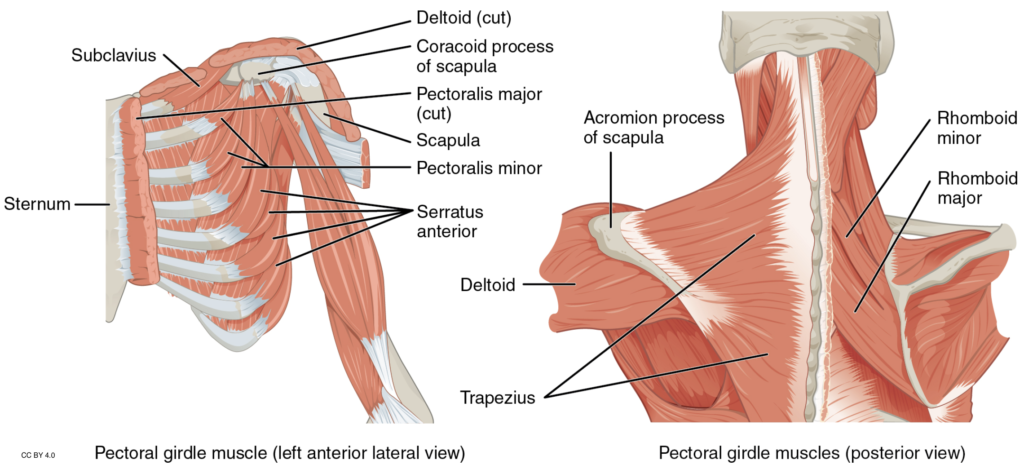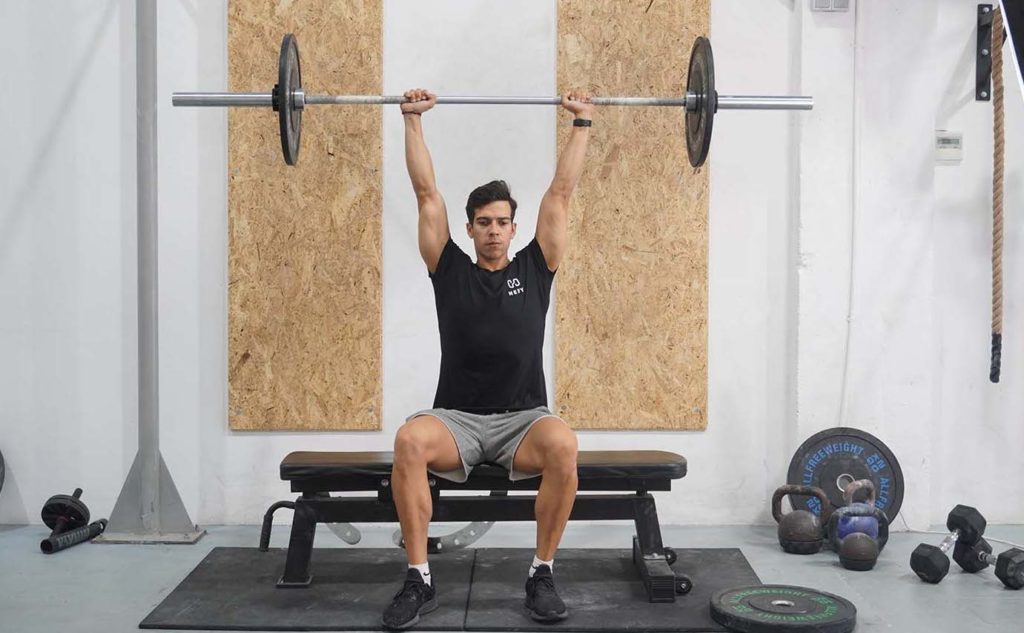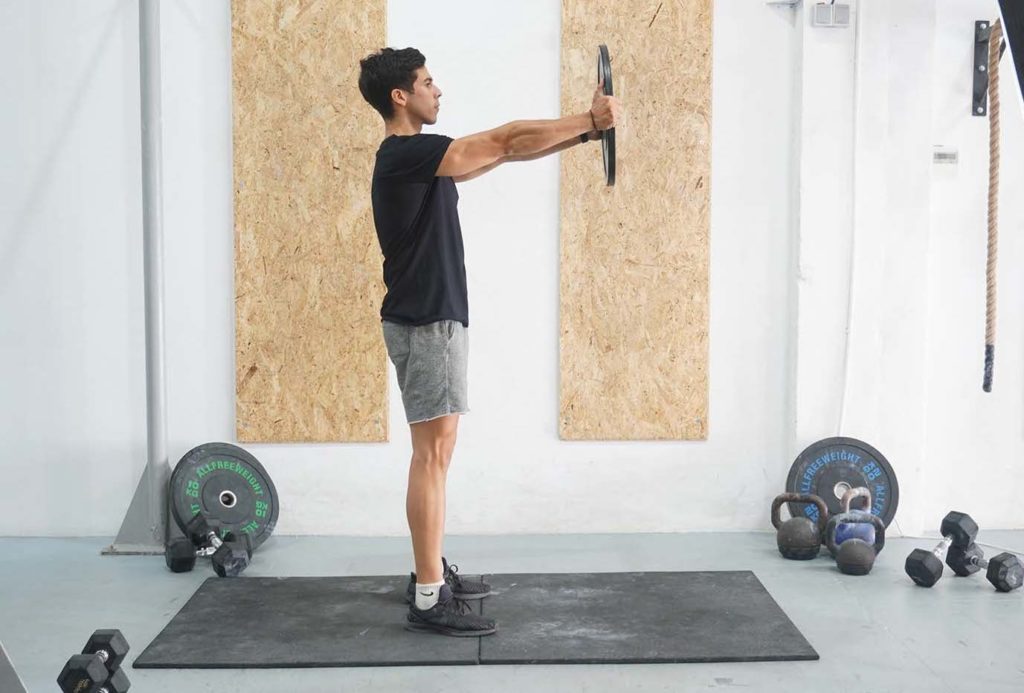The shoulders, commonly known as deltoids, are the muscles that surround the shoulder joint and produce a wide range of arm motions (1).
Despite their small size, the deltoids consist of three heads (front, middle, and posterior) that work together to produce movement at the shoulder joint (1).
Developing all three deltoid areas contributes to the round and muscular look everyone desires and promotes healthy shoulder joints.
Let’s review the best exercises for the deltoids, how they differ, and cover some good ways to organize your training.

Compound and Isolation Exercises
Compound exercises train multiple muscle groups simultaneously and involve two or more joints.
A notable example of a compound shoulder exercise is the overhead press. The movement trains the deltoids, upper chest, triceps, back, and midsection, involving the shoulder and elbow joints (2).
Isolation movements focus on a single muscle group and involve one joint.
An example of such shoulder exercise is the dumbbell lateral raise. It primarily trains the middle deltoid head and involves one joint: the shoulder (3).
When to Do Compound or Isolation Exercises
Compound shoulder exercises should take priority over isolation movements because they are more challenging to perform, and the risk of technique breakdown is greater.
You should begin your workouts with compound activities because that would allow you to perform at your best, stay safe, and provide your body with a potent growth stimulus.
Once finished with the compound exercises, you can move to isolation activities to do extra sets, focus on specific areas you want to improve and produce metabolic stress, which is necessary for hypertrophy (4).
Here is a sample shoulder workout following these rules:
Shoulder Workout (Compound and Isolation Exercises)
| Exercise | Sets | Reps | Type |
| Overhead Press (Barbell) | 3 | 6 to 10 | Compound |
| Upright Row (Barbell) | 3 | 8 to 10 | Compound |
| Shoulder Press (Dumbbell) | 3 | 10 to 12 | Compound |
| Lateral Raise (Dumbbell) | 3 | 12 to 20 | Isolation |
| Face Pull | 3 | 15 to 25 | Isolation |
You should structure your shoulder training by following the same rules regardless of your training split.
For example, let’s say that you follow a push/pull/legs split, where you train your shoulders, triceps, and chest together.
Here is how a workout might look:
Push Workout Example (Push/Pull/Legs Split)
| Exercise | Sets | Reps | Type |
| Bench Press (Barbell) | 3 | 5 to 10 | Compound |
| Shoulder Press (Dumbbell) | 3 | 8 to 12 | Compound |
| Decline Push Up | 3 | 10 to 20 | Compound |
| Skullcrusher (Barbell) | 3 | 8 to 15 | Isolation |
| Lateral Raise (Dumbbell) | 3 | 12 to 20 | Isolation |
| Cable Fly Crossover | 3 | 12 to 20 | Isolation |
You simply work the shoulder exercises inside the workout, first doing the compound activities and finishing with isolation work.
If you need assistance tracking your workouts and monitoring your progress, try using the Hevy App.

Hevy – Workout Tracker







Hevy – Workout Tracker
Create your shoulder workout with Hevy, and track your progress
The same goes for full-body training, a bro split, or upper/lower workouts.
Related article: Shoulder Workout for Strength and to Build Mass
List of 9 of the Best Compound Shoulder Exercises and Variations
1. Overhead Press (Barbell and Dumbbell)


The overhead press is one of the classic compound shoulder exercises that develops the deltoids, triceps, and shoulders (2). Performing the movement from a standing position leads to greater instability, resulting in superior midsection activation.
To perform these, stand tall with a weight in your hands, lift it to your chin, and have your feet shoulder-width apart. Retract your shoulder blades, inhale, and press the weight overhead.
A barbell allows you to use more weight, whereas dumbbells force both sides to work independently, reducing the risk of muscle imbalances.
You can train with more weight for fewer reps and build strength or lift lighter loads for more reps for endurance and metabolic stress.
2. Seated Overhead Press (Barbell and Dumbbell)


Seated overhead presses are similar to the standing version, apart from one notable difference:
Instead of standing, you’re in a seated position. As a result, you can lift more weight and maintain your position more easily.
Like the standing version, you can train both sides simultaneously with a barbell or use dumbbells to prevent muscle imbalances.
You can even train one side at a time using a dumbbell or kettlebell. The variation can be helpful for people struggling to engage their deltoids during a regular overhead press.
3. Overhead Press (Smith Machine)
Trainees don’t have much love for the Smith machine because they see it as a form of cheating, given the smaller stability requirements, but it can be handy.
Performing overhead presses on a Smith machine allows you to direct your effort to pressing as much weight as possible without worrying about stability.
Similar to dumbbell and barbell presses, you can perform the exercise from a standing or seated position––whichever feels more natural.
The objective is to set the bar at the appropriate height, add weight, grab it with an overhand grip, and press in a straight vertical line, locking out your elbows at the top. Slowly lower the bar to just below your chin as you exhale.
4. Push Press


The push press is a more dynamic full-body exercise that strengthens several muscles and improves your overhead press strength (5).
Unlike a strict overhead press, where you maintain a solid body position and only press the weight up, a push press is about generating momentum off the bottom. To do that, you must dip slightly by bending your knees and thrust the barbell overhead as you extend your knees.
Generating momentum allows you to train with slightly more weight and can be a valuable exercise for overcoming a strength plateau. For example, if you’ve been struggling to add weight to the bar for months, switching to the push press for a while can kickstart progression.
The traditional push press uses a barbell, but you can perform it with a pair of dumbbells.
5. Arnold Press (Dumbbell)


Named after Arnold Schwarzenegger, the Arnold press is a more advanced overhead press variation that includes wrist rotation.
To perform the movement, you must grab a pair of dumbbells and lift them at chin level with your palms facing your body. Brace your body, retract your shoulder blades, and take a breath.
Once in position, press the dumbbells overhead while simultaneously rotating your wrists, having them face forward at the top position. Slowly lower the weights to the starting position, rotating your wrists in.
Performing the overhead press that way makes it much more challenging, forcing you to use lighter dumbbells. The upside is that rotation at the shoulder joint leads to better overall muscle activation.
6. Seated Shoulder Press (Machine)
The machine shoulder press is an easier exercise that trains your deltoids, upper chest, and triceps.
Similar to the Smith machine press, the stability requirements are much lower, allowing you to focus on pressing weight and activating the correct muscles.
To perform the movement, select the appropriate load, sit down, and grab the handles to your sides. Brace your body, inhale, and press the weight straight up, fully extending your arms at the top.
You can do the exercise with more weight for fewer reps or perform high-rep ‘burnout’ sets near the end of your workout.
7. Pike Push Up


Pike push-ups are among the best compound shoulder exercises. A notable advantage of the movement is that you can do it almost anywhere without equipment.
Instead of lifting external weights, as is the case with the seated dumbbell press, you must use your body weight for resistance.
The objective is to set yourself up for a regular push-up with your hands shoulder-width apart but raise your buttocks toward the ceiling, folding your body into a pike, similar to a gymnast. Once in position, do repetitions by bending and extending your arms.
Doing push-ups with your torso positioned that way mimics the motion of an overhead press, leading to better deltoid activation.
Elevating your feet, such as on a gym bench, makes your upper body more vertical, allowing you to target the deltoids even more.
8. Single Arm Landmine Press (Barbell)
The single-arm landmine press is one of the more underrated shoulder exercises to build muscle and unilateral strength.
To perform the movement, anchor one end of a barbell on a landmine attachment, add some weight to the opposite sleeve and raise the weight to chest level. Brace your body, have your feet shoulder-width apart, engage your abs, and inhale.
Once in the starting position, remove one hand from the barbell sleeve and press the weight forward and up, fully extending your elbow. Lower the weight to your upper chest as you exhale.
The movement is similar to a dumbbell shoulder press because both sides of your body work independently.
9. Upright Row (Barbell)
Upright rows are one of the best shoulder exercises, where instead of pressing a weight overhead, you pull it in a vertical line.
The objective is to stand tall and hold a barbell or a dumbbell in each hand with your palms facing back. Bring your shoulders back, engage your abs, and inhale. Pull the weight from your hips to your upper chest and slowly lower the bar to the starting position.
Performing the exercise through a full range of motion is necessary to engage your deltoids, biceps, and upper back effectively (6).







Hevy – Workout Tracker







Hevy – Workout Tracker
Create your shoulder workout with Hevy, and track your progress
List of 8 Isolation Shoulder Exercises and Variations
1. Lateral Raise (Dumbbell, Band, and Cable)


The lateral raise is among the best isolation shoulder exercises to build the middle deltoid area (3).
Assume the starting position with a dumbbell in each hand, your upper body tense, and your shoulder blades retracted. Inhale and engage your shoulder muscles to raise the weights laterally.
Lateral raises are ideal near the end of your shoulder workouts because the risk of technique breakdown is small, and you can pump up the shoulder muscles with high-rep sets.
Dumbbells, a resistance band, and a cable machine are viable options for resistance. You can do the exercise seated or standing and train one side at a time if you prefer.
2. Lateral Raise (Machine)
Machine lateral raises are another great exercise to strengthen and develop your shoulders.
Unlike the previous exercise, using a machine means you don’t have to worry about stability and can instead focus on raising and lowering the weight.
To perform the movement, select the appropriate weight, sit down, retract your shoulder blades, and grab the handles. Inhale and raise your arms until your elbows are at shoulder height. Lower your arms and exhale.
3. Reverse Fly (Dumbbell and Cable)
Reverse flyes are a versatile and effective shoulder exercise that develops the posterior deltoid heads.
The primary way to perform the movement is to grab a pair of dumbbells, lean your torso forward, and raise your arms, squeezing your upper back muscles at the top.
You can also do the movement by supporting yourself on an incline bench or while standing and using a cable machine (standing cable reverse fly).
Training one arm at a time can help improve muscle activation and reduce the risk of muscle imbalances.
4. Rear Delt Reverse Fly (Machine)
Reverse flyes on a machine are another effective posterior deltoid exercise. Similar to the previous activities and variations, the object is to bring your arms, forcing your upper back to engage.
A notable advantage of using a machine is that you don’t have to worry about stability. Instead, you can direct your attention to activating your shoulder muscles.
Assume the starting position with your hands straight and in front of your body, shoulder blades back, and upper body tense. Take a breath and extend your arms to your sides in one fluid motion by engaging your shoulder muscle group.
We recommend including the machine reverse fly as one of the last movements in a shoulder workout. Use a lighter weight and do up to 15 or 20 slow, controlled reps.
5. Front Raise (Barbell, Dumbbell, Cable, Plate, and Band)


Front raise variations are excellent shoulder isolation exercises that develop the front portion of the muscle (anterior deltoid) (3).
To perform the movement, extend your arms in front of your body and hold a weight, be it a straight bar, a pair of dumbbells, or something else. Engage your upper body, retract your shoulder blades together, inhale, and lift until your arms are parallel to the floor.
You can use a bar, a pair of dumbbells, a weight plate, a resistance band, or a cable machine.
6. Face Pull


Face pulls are among the best isolation exercises for shoulder development and health.
Unlike regular rows, where you keep your elbows tucked in and close to your torso, the objective during face pulls is to flare your arms. Doing so lets you pull the resistance band or rope attachment to your face, emphasizing the rear deltoids.
Perform the movement near the end of your shoulder workout, doing up to 20-25 reps per set.
7. Cable Shoulder Y Raise
Cable Y raises are among the lesser-known rear and lateral head shoulder exercises.
The movement leads to more balanced shoulder development because it forces you to bring your arms to your sides and up.
To perform the activity, set the appropriate load on a double cable machine, adjust the pulleys to the lowest position, and attach handles. Grab the handle to your left with your right hand and the one to your right with your left hand.
Stand tall, engage your abs, inhale, and engage your shoulder muscles to raise your arms overhead, crossing the cables in front of your body.
Related article: The 12 Best Cable Shoulder Exercises for Mass and Strength
8. Band Pull-Aparts
Band pull-aparts are one of the simplest and most effective movements to warm up your deltoids or finish a shoulder session.
The objective is to grab a resistance band with both hands, raise it in front of your chest, and pull it repeatedly, extending your arms to your sides. Doing so activates the middle and rear deltoid, the trapezius, and the rhomboids.
Find many other shoulder exercises on the Hevy app’s extensive exercise library







Hevy – Workout Tracker







Hevy – Workout Tracker
Create your shoulder workout with Hevy, and track your progress
Final Words
Despite the small size of the muscle, there are plenty of isolation and shoulder compound exercises you can do to target the three heads and achieve balanced development.
The overhead press is a classic shoulder-builder, but it alone isn’t enough to produce optimal muscle growth.
Optimal growth and strength gain come from the right combination of compound and isolation exercises, organized within a good training plan.
Other articles from the series:
- The Top 7 Isolation And 7 Compound Ab Exercises
- 10 Compound and 4 Isolation Back Exercises for an Impressive V-Taper
- 8 Isolation and 7 Compound Bicep Exercises For Big Arms
- 8 Compound and 6 Isolation Chest Exercises for Strong Pecs
- 5 Isolation and 9 Glute Compound Exercises for a Head-Turning Behind
- 7 Isolation and 8 Compound Leg Exercises for a Strong Lower Body
- 7 Isolation and 7 Compound Tricep Exercises For Big Arms









